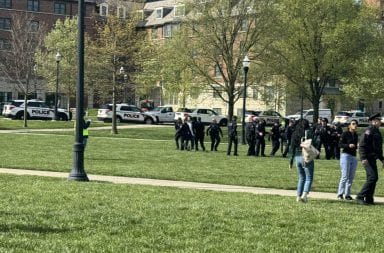Reading through the crime briefs in The Lantern, it is clear that the politics of race are often playing out in both the actual reports as well as the comment sections. Last week, Everdeen Mason’s column attempted to explain the difficulties of reporting race and sought to explain the paper’s policy with regard to mentioning the race of the suspects. However, rather than providing a sound justification for the policy, there are a number of unanswered and unaddressed questions and concerns.
According to the editorial, The Lantern simply reproduces the details provided by the police, including the race of a suspect. After asserting that both black males and white males do in fact commit crime, the author asks how the paper is “perpetuating a stereotype by reporting what happened?”
First, it is not enough for a newspaper or other media outlet to justify a policy by saying that they write whatever the police tell them. Also, asserting that black and white males alike commit crime does not rebut or dismiss the claim of racism. It is not about denying that people from different racial and ethnic groups commit crimes, but rather to highlight the over-representation of African-American or Latino descriptors or faces in crime reports.
The editorial stated that The Lantern provides descriptive information about “criminals” because “people are drawn to crime and disasters” and “want to imagine who these people are.” These are unsubstantiated assumptions about readers that cannot serve as the basis for an important policy. [Editor’s note: The column did not state these reasons as the basis for the standing policy of the newspaper.]
The column states that journalists cannot help how people perceive their descriptions. However, language is not neutral and can shape the way people understand their reality. It is essential for all journalists to think critically about language and remain cognizant of how it operates within a given context.
That article talks about the importance of not giving into political correctness. There is a general misunderstanding around the term political correctness as conservatives have manipulated it for political gain over the years. It has become fashionable to introduce the term in a debate because it replaces the need to make a substantive argument and shuts down other views.
Despite the headline “Reporting race a struggle,” the article does not actually delve into reporting on race, which includes issues such as media representation of racial and ethnic groups, the language and framing in stories involving race, when and how race is recognized in different articles, and the lack of diversity in newsrooms, among others.
Many studies have shown that there is a clear race prejudice in the media. A report titled “Off Balance: Youth, Race & Crime in the News” analyzes a number of the studies on race and the media from the 1990s. According to the report, the homicide coverage was increasing on the network news by 473% from 1990 to 1998 while homicides dropped by nearly 33% during the same period.
The report finds that African Americans are underrepresented as victims and overrepresented as perpetrators in the news. Articles about white homicide victims tend to be longer, and more frequent than the articles that cover African-American victims.
Emily Drew’s research in “Beyond Journalistic Jingoism” analyzes 28 newspapers that at different times featured segments centered on race relations. According to Drew, many of the headlines “failed to provide a social context that did anything better than blame the people for their social reality.” Also, the articles missed out on opportunities to talk about institutional racism and instead reinforced existing racial attitudes.
Fortunately, the experience of focusing on race changed the dynamics within newspapers with regard to journalists’ perceptions of one another and a new-found honesty and self-reflexivity about their own publication’s perpetuation of racial stereotypes. This is an important lesson for journalists and newspapers like The Lantern considering the continuing significance of race in our society.


